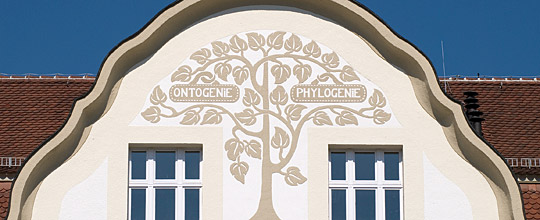Information
Founded by Ernst Haeckel, the Phyletisches Museum is a globally unique institution. It is not just a natural history museum, but has been, from the start, a place dedicated to illustrating the development of life. Its main areas of focus are phylogeny and the theory of evolution, and it also celebrates the meeting of art and nature. The façade of the Art nouveau building, itself a cultural monument, is adorned with two important terms which Haeckel coined in Jena: Ontogenie (ontogeny) and Phylogenie (phylogeny).
The Phyletisches Museum was set up using donated funds, and the foundation stone was laid on Goethe’s birthday on August 28, 1907. On July 30, 1908, Haeckel consigned the building to the Friedrich-Schiller University on the occasion of the university’s 350th anniversary. Today the museum forms part of the university’s »Institut für Spezielle Zoologie und Evolutionsbiologie« (Institute of Systematic Zoology and Evolutionary Biology). It accommodates extensive zoological and palaeontological collections comprising more than 500,000 specimens. The history of the collections dates back to the 18th century. Some of the most important specimens originate from the period when Goethe (1749–1832) curated the anatomical-zoological collections.
The Phyletisches Museum welcomes more than 300 school classes and 20,000 visitors each year. Thanks to the support of numerous donors, we regularly show two special exhibitions per year since 1995.



